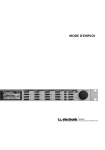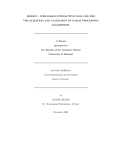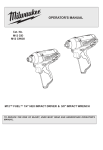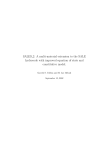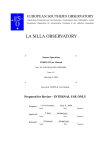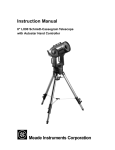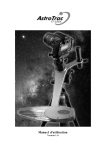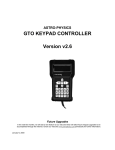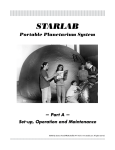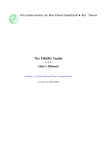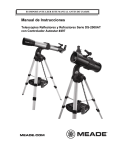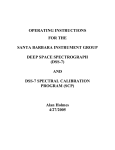Download Getting the Most from a CCD Spectrograph.
Transcript
astro imaging Getting the Most from a CCD Spectrograph Amateurs with backyard telescopes are taking their own spectra of stars, nebulae, and galaxies. But there’s more D uring the latter half of the 19th century, amateur astronomers such as Henry Draper, Lewis Rutherfurd, and William and Margaret Huggins took the lead in developing new spectroscopic techniques for astronomy that helped establish the emerging field of astrophysics. Dissecting starlight by wavelength allowed astronomers to determine the physical nature of the Sun and stars, revealing their chemical compositions, radial velocities, and internal motions. By Sheila Kannappan and Daniel Fabricant A century later, high-efficiency CCD spectrographs allow today’s amateurs to obtain high-quality spectra from their backyards, using telescopes no larger than the ubiquitous 8-inch Schmidt-Cassegrain. Even under light-polluted skies, such equipment reveals a fascinating variety of features in the spectra of bright stars. We recently built a fiber-fed CCD spectrograph for use by students in Harvard University’s astronomy courses. Attached to a 16-inch telescope, it captured the spectra accompanying this article from the roof of Harvard’s Science Center, right in the heart of downtown Cambridge, Massachusetts. We use it to observe bright stars and planets as well as emission lines in deep-sky objects such as the Orion Nebula and the spiral galaxy M77. While enterprising amateurs can build their own spectrographs, both Sivo Scientific (www.sivo.com) and Santa Barbara Instrument Group (www.sbig.com) offer commercial units designed for astronomical work. In this article we present some interesting spectroscopy projects that can All the spectra with this article were recorded at the rooftop observatory on Harvard University’s Science Center under some of North America’s most light-polluted skies. Sheila Kannappan (center) built the observatory’s spectrograph as a graduate-student project with advice from coauthor Daniel Fabricant (left) and expert machining assistance from Charles Hughes (right). S&T: CRAIG MICHAEL UTTER to it than just recording a spectrum’s image. Sky & Telescope July 2000 125 ® TELESCOPES Seeing the real Universe PRESS RELEASE: MURNAGHAN Instruments Buys Coulter Optical® Assets. Production of Odyssey® Telescopes will continue. New product benefits from financial stability and management of MURNAGHAN Instruments Corporation. ® S&T: CRAIG MICHAEL UTTER THE ODYSSEY ADVANTAGE • No assembly required • Improved Dob mount and focuser • Double-strength Sonotube • Eyepiece included • Many options available • Lowest prices anywhere The observatory’s Meade 16-inch telescope was used for the spectra with this article. from 8-INCH f/4.5 $39995 • Deep-space scope • Tube 36 × 10.5 inches • Diffraction-limited optics • Includes wide-field eyepiece • Reengineered mount system from 8-INCH f/7 $39995 • Lunar/planetary scope • Tube 56 × 10.5 inches • Diffraction-limited optics • Includes high-magnification eyepiece • Extra-stable mount from 10-INCH f/4.5 $54995 • Extremely portable • Tube 45 × 12.7 inches • Diffraction-limited optics • Includes wide-field eyepiece • Improved mount system 13.1-INCH f/4.5 $89995 • A BIG scope for less money • Easy 1-person setup • Tube 57 × 15.7 inches • Diffraction-limited optics • Includes wide-field eyepiece HOW TO ORDER Send no money. A deposit is NEVER required to process your order. Pay just before shipment by check, money order, Visa, or MasterCard. For orders or information: Call 1-561-795-2201 Web: www.murni.com Fax: 1-561-795-9889 ew The NCoulter ® Optical Div. MURNAGHAN Instruments TM 1781 Primrose Ln. West Palm Beach, FL 33414 Bigger Scopes . . . Better Optics . . . Less Money 126 July 2000 Sky & Telescope be done with CCD spectrographs. We also review the basic concepts of spectroscopy and the steps involved in obtaining and calibrating spectroscopic data. Amateurs are already demonstrating a remarkable proficiency with CCD spectrographs. One of the most impressive examples we have seen is Maurice Gavin’s galaxy and quasar redshift measurements (S&T: June 1999, page 14). The box on page 127 illustrates an easier and equally entertaining project — observing the life cycle of stars. We obtained most of the spectra shown with exposures of 30 seconds or less. The table on page 128 summarizes the technical requirements for several spectroscopy projects suited to amateur equipment. All are within the capabilities of an 8-inch telescope and a high-quality spectrograph. Typical projects fall into two main categories: measuring spectral properties to determine chemical and physical processes in celestial objects and measuring the objects’ radial velocities (speeds along the observer’s line of sight). The following brief review of the basic concepts involved can be supplemented with material in books such as James Kaler’s Stars and Their Spectra (W. H. Freeman, 1997) and Lawrence Aller’s Atoms, Stars, and Nebulae (Cambridge University Press, 1991). Measuring Spectral Properties Generally speaking, a spectrum consists of a continuum (light spread over a broad, continuous range of wavelengths) as well as some narrow spectral features or lines superposed on it. The continuum alone often reveals something about the conditions under which the light was produced. In the case of normal stars, it represents light emitted by the star’s photosphere (visible surface). This light is primarily thermal blackbody radiation, and thus the wavelength of its peak intensity indicates the photosphere’s temperature. Hot O and B stars glow brightest at blue wavelengths, while our Sun, which is cooler, emits the most light at yellow and green wavelengths. The coolest, “late-type” stars appear redder. Many spectra show dark absorption lines and emission lines, which tell of other physical processes. The dark lines arise when molecules and atoms in a star’s atmosphere absorb continuum light at specific wavelengths. Late-type stars show spectra rich in “metal” (heavy-element) absorption lines and sometimes broad bands of molecular absorption. In hotter stars molecules are disrupted and metals are ionized, so most of the absorption lines disappear at visible wavelengths. On the other hand, these “earlytype” stars show the hydrogen Balmer series of absorption lines prominently. These hydrogen lines can also appear as emission features — bright lines in the spectrum — under different physical conditions. For example, radiation from hot O and B stars can ionize surrounding gas clouds and produce line-emitting “H II regions” (astronomer’s shorthand for ionized hydrogen clouds) such as the Orion Nebula. Hydrogen emission lines, along with a host of others from elements such as oxygen, nitrogen, and sulfur, are common in the spectra of gaseous nebulae. Measuring Velocities When a light source is moving along our line of sight, we can measure its velocity using the Doppler shift. Just as the pitch of a train whistle rises and falls as the train approaches and then recedes, light waves are blueshifted to higher frequencies when they come from an approaching source and are redshifted to lower frequencies for a receding source. The formula for this shift is v/c = ∆λ/λ, where λ is the wavelength of the spectral feature for a source at rest, ∆λ is the change in the wavelength, c is the speed of light, and v is the velocity of the source relative to the observer. The ex- The Life of a Star Birth. Star-forming regions such as the Orion Nebula glow with the light of young, hot stars as well as light from the ionized gas bubbles these stars carve out of the cold gas clouds around them. As the bubbles expand, their shock fronts can compress the rest of the cloud, driving additional waves of star formation. The strong lines in the Orion Nebula’s spectrum include the hydrogen Balmer series of emission lines, starting with hydrogen-alpha (656.3 nanometers) and hydrogenbeta (486.1), as well as emission lines of ionized nitrogen (N II at 654.8 and 658.4) and twice-ionized oxygen (O III at 495.9 and 500.7). Hydrogen-alpha Doubly ionized oxygen 500 550 600 650 Wavelength (nanometers) Midlife. Most stars fall into the familiar OBAFGKM spectral-classifica- Hydrogen-alpha B8 Hydrogenbeta tion system. The earliest types, O and B, represent the hottest, brightest, and most massive stars, while the later types may be either dwarfs on the main sequence or giants that have left it. To the eye, early-type stars like Vega appear pale bluish, while late types like Betelgeuse appear reddish. An intermediate star such as the Sun (a G dwarf) appears pale yellow. The reason is clear from the shapes of the continuum spectra below — the hotter the star, the more energy it emits at shorter, bluer wavelengths, following the law of blackbody radiation. Stellar absorption lines also vary by star type. The Balmer series of lines, including hydrogen-alpha and -beta, are strongest for A stars, while later-type stars are rich in metal lines such as iron (527.0 nanometers), the sodium D doublet (about 589.5), the magnesium triplet (about 517.5), and the calcium-iron blend (about 649.5). Although such metals are also present in early-type stars, at the hotter temperatures they are more highly ionized, so the neutral metal lines disappear from the spectrum. In the very latest-type stars, molecular gas forms in the star’s cool outer atmosphere and causes broad absorption bands such Stellar Types Algol A0 Relative intensity Ammonia absorption band Jupiter Planetary Spectra Saturn Methane absorption band 500 Vega F2 Relative intensity Relative intensity Hydrogenbeta Old Age and Death. As stars grow old they bloat, oscillate, and explode, leaving tiny remnants made of exotic matter. Massive stars may die gloriously in supernova explosions, while less massive stars such as the Sun will form planetary nebulae. Both processes enrich the interstellar gas and provide raw materials for future generations of stars. In our Harvard program we haven’t yet captured the spectrum of a supernova, but we have recorded the spectra of planetary nebulae. Equally spectacular are the spectra of aging stars such as the well-known variables Mira Mira (Omicron Ceti) and Gamma Cassiopeiae. Mira is surrounded by a patchy, dusty envelope, and its spectrum has a bizarrely sawtoothed structure caused by 500 550 600 650 titanium-oxide absorption Wavelength (nanometers) features. Low-mass stars such as the Sun are likely to go Gamma Hydrogenthrough a similar stage late beta Cassiopeiae in their lives before finally Hydrogenejecting their envelopes and alpha settling down as white dwarfs. Gamma Cassiopeiae is orbited by just such a remnant companion — either a white dwarf or a neutron star. 500 550 600 650 Wavelength (nanometers) The companion, a bright Xray source, sucks matter from Gamma Cassiopeiae, and this gas produces Balmer-series emission lines superposed on the bright star’s B-type stellar spectrum. Relative intensity Relative intensity Orion Nebula as the titanium-oxide bands at about 590 and 625 nanometers and other wavelengths. 550 600 650 Wavelength (nanometers) β Cassiopeiae G2 Planets. Planets shine by the reflected light of the Sun, but their at- α Aquarii Magnesium K0 Sodium Iron Calcium-iron α Cassiopeiae K5 Aldebaran 500 550 600 Wavelength (nanometers) 650 mospheres may reprocess that light in interesting ways. Above, the spectra of Jupiter and Saturn reveal a broad methane-absorption feature at about 620 nanometers superposed on the reflected G-type solar spectrum. Jupiter’s atmosphere also creates an ammonia-absorption feature from 640 to 650 nanometers. Both spectra are somewhat redder than the Sun’s because the planets’ atmospheres preferentially reflect red light. Sky & Telescope July 2000 127 astro imaging Spectroscopy-Project Ideas Project Stellar spectral types Solar-system objects Variable stars Supernova identification Required resolution (nanometers) 1 1 Spectral range (nanometers) 470–670 470–670 Magnitude range 0–5 0–10 1 1 470–670 350–700 Stellar radial velocities 0.3 470–670 3–15 Limited only by your ambition 0–5 Nebular emission lines 1+ 470–670 14+ Galaxy redshifts 1+ 650–700 (for example) 470–780 (or any subrange) 14+ Emission lines in active galactic nuclei (AGNs) including quasars 0.3–1+ pansion of the universe also produces a cosmic redshift, defined as z = ∆λ/λ. Cosmic redshifts are often converted into units of velocity according to v = cz for small values of z. In addition to displacing the wavelengths of spectral lines, Doppler shifts can also broaden the lines if material is moving at a range of different velocities. T 14+ Some of the broadest lines result from material swirling around and falling into black holes at the centers of galaxies. In such cases a velocity spread of about 1,000 kilometers per second is often observed. The ability to measure line broadening is directly limited by the wavelength resolution of a spectrograph, which can be he first total solar eclipse of the new millennium occurs on June 21, 2001, in exotic southern Africa. Sky & Telescope and Scientific Expeditions will be there, and we invite you to join us! We’ll rendezvous with the Moon’s shadow in Zambia, where weather prospects are excellent and totality lasts nearly 4 minutes. We’ll also go on safari in South Africa’s best game reserves, visit majestic Victoria Falls, and view the spectacular southern sky with the Milky Way high overhead and the Magellanic Clouds near the meridian. Our 11-day expeditions begin June 15th. Prices start at $5,325 per person, based on double occupancy. Space is limited — make your reservation today! Scientific Expeditions, Inc. For more information 227 West Miami Ave., Suite #3 call toll free Venice, FL 34285 800-344-6867 Fax: 941-485-0647 ® or point your Web browser to http://www.skypub.com/ E-mail: [email protected] store/scienx/africa2001.html 128 July 2000 Sky & Telescope Notes 350–900 better 350–900 better. Outer planets hard to track 350–900 better 0.5-nanometer resolution better. Smaller range okay Requires careful wavelength calibration Lower resolution a help for faint targets Choose range based on redshift and desired lines Choose subrange based on redshift and desired lines converted into velocity units using the Doppler shift formula given above, where ∆λ is the wavelength resolution, λ is the central wavelength being observed, and the velocity resolution v is the result of the calculation. However, one can often measure overall redshifts and blueshifts with a precision much better than the resolution limit. African ECLIPSE Safari CCD counts Calibrating a Spectrum 0 100 550 600 200 650 200 300 Wavelength Calibrated 300 Pixel Number Optical Astronomy Observatory (http:// iraf.noao.edu/iraf/web/). Unfortunately, IRAF has a steep learning curve and runs only on Unix or Linux operating systems. Another powerful analysis program is Research Systems’s IDL (www. rsinc.com). Although quite expensive, it is user friendly and will run on any computer platform. Free astronomy tools for IDL are available on the Web (http:// idlastro.gsfc.nasa.gov/homepage.html). WaveMetrics’ IGOR (www.wavemetrics. com) is much less expensive than IDL, and it offers extensive built-in graphing and analysis features as well as programming capabilities. IGOR was not designed specifically for astronomy, but it is flexible and the user’s manual and technical support are excellent. Some other programs that may be useful include Maxim DL (www.cyanogen. com), PDL (the Perl Data Language, available free from http://www.aao.gov. au/local/www/kgb/pdl/), and DS9 (a quick-look program we use to check exposure levels of the data obtained at the telescope, available free from http://heawww.harvard.edu/RD/ds9/). DS9 lets you 500 550 600 650 Wavelength (nanometers) Relative intensity Transforming images from a CCD spectrograph into useful spectra requires a series of calibration steps. The authors’ fiber-fed spectrograph produces a discrete spectrum for each of its six fibers. At top is the featureless-looking spectrum image for the star Algol, the light of which fell on a single fiber. Plotting the brightness of rows of pixels spanning this spectrum produces the raw-data graph. Another spectrum image of light from a mercury-neon calibration lamp (illuminating all six fibers) and its corresponding plot determines the wavelength recorded by each pixel in the row and is used to wavelength calibrate the astronomical spectrum. This spectrum, however, is still highly distorted because of instrumental effects, in particular the varying spectral sensitivity of the CCD detector. Only when flux calibrated (see page 130) does the plot accurately reveal Algol’s spectral features. Hardware and Software In addition to a spectrograph and telescope, a handy piece of auxiliary equipment is a calibration lamp. An ideal lamp has many narrow emission lines throughout the wavelength range of interest. These lines are useful for focusing the spectrograph and determining wavelengths within a spectrum. With our student spectrograph we use a mercury-neon lamp sold by Oriel Instruments (150 Long Beach Blvd., Stratford, CT 06615; www.oriel.com). Spectral-analysis software is not as mature as the image-processing programs widely available to today’s amateur astronomers. Nevertheless, you will need analysis software to perform essential calibration of your CCD spectra, without which the spectra will appear distorted and difficult to interpret. Commercial units such as the SBIG spectrograph usually come with basic software, but you may need to supplement it. Professional astronomers often process their spectral data using IRAF, the free image-processing and data-analysis software available from the National 100 Pixel Number CCD counts Wavelength (nanometers) 500 Extracted Spectrum After Bias Subtraction 0 Neon (650.65) Neon (614.31) Mercury (546.07) CCD counts Mercury (491.80) Mercury-Neon Calibration Lamp Raw Data Flux Calibrated 500 550 600 650 Wavelength (nanometers) run a mouse over a CCD image and instantly obtain an intensity plot for the row of pixels under the cursor. Exposure Times Spectroscopy in general, and high-resolution spectroscopy in particular, requires longer exposure times than conventional imaging. This is because light from a star or other source is spread into a spectrum that covers many pixels on the CCD rather than being concentrated onto just a few as in direct imaging. The more widely the light is spread out into a spectrum, the more sharply we can resolve closely spaced spectral features. But this higher resolution comes at the expense of diluting the light and thus requires longer exposures. Many other factors also affect exposure time — telescope aperture, spectrograph efficiency, noise characteristics of the CCD camera, and sky brightness, to name a few. Rather than modeling all these factors, we have found the easiest way to make exposure calculations is by scaling from other spectroscopic observations of similar objects. Once you have obtained sucSky & Telescope July 2000 129 astro imaging cessful spectra for a few objects, simply multiply those exposures by a factor of 2.5 for each magnitude fainter that you wish to observe. This technique works only for stars, since typically just a small fraction of the light from extended objects passes through a spectrograph slit. On the other hand, an emission nebula is sometimes much easier to observe with a spectrograph than its surface brightness would imply, since almost all of its light will be concentrated in a few bright emission lines rather than spread across a continuum. With our 16-inch telescope and the spectrograph operating at 0.6-nanometer resolution, we obtain the spectrum of a 2nd-magnitude star with a 10-second exposure. Switching to 1.6-nanometer resolution, we can get a spectrum of the Ring Nebula or the galaxy M77 by combining a pair of 5-to-10-minute exposures. Since the characteristics of most amateur spectrographs will be roughly comparable to ours, these exposure times will approximately scale by telescope aperture for point sources. For example, an 8-inch telescope has one-quarter the light-collecting area of our 16-inch, so it would need a 40-second exposure for a 2nd-magnitude star. For extended sources, the exposure time will also depend on what fraction of the object is imaged onto the spectrograph’s entrance aperture — decreasing a telescope’s focal length or increasing the entrance aperture will decrease the exposure time. Just as with conventional CCD imaging, exposures longer than about 10 minutes should be “assembled” from a series of shorter exposures to make it easy to remove things like cosmic-ray artifacts from the final image. Calibration Unlike a raw pictorial image, a raw spectrograph image does not always resemble the final calibrated data that will be extracted from it. Without calibration, the raw frame yields a spectrum that is highly distorted by the way the telescope and spectrograph transmit and detect different wavelengths of light. Fortunately, most of this distortion can be removed with a basic calibration procedure that corrects for everything except atmospheric absorption. We applied this sort of minimal processing to calibrate the spectra with this article. The data reduction consists of three essential parts: background subtraction, wavelength calibration, and flux calibration. Background subtraction removes unwanted signal in the spectra due to the CCD’s bias and dark current as well as light pollution from the sky. A simple way to accomplish this is to take an identical exposure of the blank sky next to the object and subtract it from the spectrum image. Unfortunately, this method wastes precious observing time, so we usually use a different procedure. Since bias subtraction is a necessary step for any further calibration, we remove the bias and the dark current simultaneously by subtracting the average pixel value obtained from pixels on the CCD adjacent to those recording the spectrum. While this method is not perfect (using an average value does not take into account unusually “hot” or Flux Calibrating CCD Spectra T he table on page 131 lists some bright stars for which reference spectra, sampled every 1.6 nanometers (16 angstroms) between 330 and 755 nanometers, are available on the Web (http://adc.gsfc. nasa.gov/adc-cgi/cat.pl?/catalogs/2/2179/). The fluxes in the reference spectra are given in monochromatic magnitudes, which may be converted to absolute flux at any given wavelength using the equation For example, the reference star HR 8634 has a monochromatic magnitude of +3.4 at a wavelength of 555.6 nanometers. Evaluating the above equation gives an absolute flux of about 430 photons per square centimeter per second per nanometer at this wavelength. Because a CCD’s pixel value is directly proportional to the number of photons striking it (as long as the pixel value remains well below its saturation level) you can perform a first-order flux calibration by dividing your observed spectrum of a standard star into the star’s reference spectrum obtained from the Web site. (Before dividing, you may need to manipulate the reference spectrum to match the range and resolution of the ob- F λ = 5.5 × 106 (1/λ) 10 –0.4(mag), where Fλ is given in photons per square centimeter per second per nanometer, λ is the wavelength in nanometers, and mag is the monochromatic magnitude. served spectrum.) The result will be a ratio of the star’s “official” spectrum to the spectrum your equipment recorded at the various wavelengths. It is now a simple matter to multiply all your spectra by this correction. Doing this removes all flux distortions introduced by your equipment. If you don’t care about the details of atmospheric absorption or about getting absolute flux levels, then this procedure is all you need. In fact, the spectra accompanying this article were reduced by this method. Furthermore, you can reuse the same standard-star data over and over if your setup doesn’t change. We use one calibration for many nights. Saturn calibrated uncalibrated 500 550 600 Wavelength (nanometers) 130 Relative intensity Relative intensity Methane absorption band July 2000 Sky & Telescope 650 Algol calibrated uncalibrated 500 550 600 Wavelength (nanometers) 650 “cold” pixels), it is adequate for brightstar work, where there is a lot of signal relative to the level of the bias and dark current. For fainter targets it is important to subtract the sky background as well as the pixel-by-pixel bias and dark current, because an errant pixel or emission from skyglow could easily be mistaken for a real feature in a weak spectrum. With a slit-type spectrograph, the sky is present across the whole slit, so its level can be estimated from pixels adjacent to the target’s spectrum. Our spectrograph uses optical fibers to transfer light from the telescope to the spectrograph, where the fibers are arranged in a line to act like an entrance slit. With this system a fiber at the telescope’s focal plane can be positioned on blank sky to record the background while a matching fiber is positioned on the target. To remove the sky background, we wavelength-calibrate the sky’s spectrum as described below and subtract it from the target’s wavelengthcalibrated spectrum. With very long exposures, cosmic-ray artifacts become a problem. In this case, multiple exposures should be taken and ZIP OUT ROOF Bright Standard Stars Star 29 Piscium ξ2 Ceti π2 Orionis η Hydrae θ Crateris θ Virginis 108 Virginis 58 Aquili ε Aquarii ζ Pegasi Designation HR 9087 HR 718 HR 1544 HR 3454 HR 4468 HR 4963 HR 5501 HR 7596 HR 7950 HR 8634 R.A. (2000.0) Dec. 00h 01m 50s –03 01.7 02h 28m 10s +08 27.6 04h 50m 37s +08 54.0 08h 43m 14s +03 23.9 11h 36m 41s –09 48.1 13h 09m 57s –05 32.3 +00 43.0 14h 45m 30s +00 16.4 19h 54m 45s 20h 47m 41s –09 29.8 22h 41m 28s +10 49.9 any artifacts identified in a search for small bright spots that appear in one image but not the others. These can be removed when the spectra are added together. The goal of wavelength calibration is to determine the wavelength at each pixel in the spectrum. Fortunately, a spectrograph that uses a diffraction grating to disperse light has, to a first approximation, a linear relationship between wavelength and pixel position. Thus, a few recognizable emission or absorption lines in the image will provide enough information to determine the AFTER BEFORE EASY SETUP DURABLE PORTABLE RAINFLY $390.00 ROOMY ETX............$30.00 C5..ETX 125....$30.00 AP 105mm..$30.00 AP 130mm..$30.00 AP 155mm..$35.00 7” Mak........$40.00 8” SCT........$40.00 9.25” SCT.....$45.00 10” 11” 12” 14” SCT........$45.00 SCT........$50.00 SCT........$55.00 SCT........$60.00 Magnitude 5.1 4.3 4.4 4.3 4.7 4.4 5.7 5.6 3.8 3.4 Spectral type B7 III–IV B9 III A1 V B3 V B9.5 V A1 I B9.5 V A0 III A1 V B8 V entire wavelength scale. The simplest solution is to observe an astronomical source with strong and easily identifiable lines, such as the Orion Nebula or Gamma Cassiopeiae. In this case you may wish to compensate for any Doppler shift in the reference spectra due to the object’s radial velocity. A more accurate wavelength calibration requires the spectrum of a calibration lamp. The stability of this wavelength calibration throughout the night depends on whether the spectrograph optics flex as the telescope moves or the temperature changes. With our fiber-fed, bench- controller..............$70.00 .965”.....................$33.00 1.25”.....................$35.00 2”.........................$38.00 3”.........................$40.00 4”.........................$43.00 5”.........................$45.00 6”..........................$48.00 7/8”......................$50.00 9/10”..................$60.00 11”.....................$65.00 12”.......................$70.00 14/16”..................$80.00 Telrad heater..............$23.00 Telescope computer control heater ...........................$35.00 Felt lined Flexible Dewcaps ETX.....................................$25.00 C5 / ETX 125....................$32.00 6”..........................................$42.00 7”/C8”..................................$50.00 C9.25...................................$55.00 10”........................................$60.00 C11”.....................................$70.00 12”........................................$85.00 C14”..................................$105.00 4 ZIP OUT SLOTS LIGHTPROOF FAST SETUP PORTABLE DURABLE ROOMY $375.00 ULTIMATE......$125.00 Optional rain fly $95.00 ULTIMATE II...$160.00 Ultimate II has a folding accessory tray for eyepieces filters, charts etc. Made from Baltic Birch Plywood. Seat is adjustable from 9” to32” Buy Direct or from your favourite dealer Collimators for Schmidt Cassegraines and Newtonians 1.25” ....$100.00 2” .........$110.00 SCT.......$160.00 SCT-NGF-s....$175.00 ........ Flexible, Felt lined, Durable. Save up to 85% vs Brand Name. 12V 17 AMP HOUR Comes with float charger, carry bag, built in fused cigarette lighter power socket. ....$125.00 33 AMP HOUR BATTERY Face of collimator angled at 45° for easy reading. 4 fused power plugs, LCD for state of charge, 1 amp float charger, carry bag Comes in two configurations We are the exclusive North American distributors for Coronado Instruments H-Alpha filters and telescopes. Dealer inquiries welcome. 12 volt......$290.00 18 volt......$390.00 ASP 60..............$2625.00 ASP 60/BF30....$3125.00 AS1 90..............$7200.00 Helios 1............$2925.00 18 volt version is for LX 200 owners. One plug has a built in inverter for 18 volt output. We accept all major credit cards KENDRICK ASTRO INSTRUMENTS 2920 Dundas St. West, Toronto, Ont M6P 1Y8, Canada Tel 416 762 7946 Fax 416 762 2765 kendrick-ai.com email: [email protected] Sky & Telescope July 2000 131 mounted spectrograph, we can use a single wavelength calibration for an entire night and indeed for weeks. Flux calibration involves observing a standard star, dividing its spectrum as recorded by the spectrograph by its “official” spectrum as determined from a reference database, and using the result to correct the flux levels of the rest of your data (see the box on page 130). Because there are only a few bright standard stars, there will not always be one conveniently placed for calibration. As an alternative, if you don’t need an accurate flux calibration but just want to remove gross instrumental distortions, you may prefer to record the spectrum of a bright star with the same spectral type and luminosity class as one of the standard stars, and then compare the spectra. (Stellar classification information is available on the Web at http://simbad.harvard. edu.) This strategy has the advantage of giving you a wider choice of calibration stars at the expense of introducing small errors due to differences in spectral shape and radial velocity. A remaining concern is atmospheric absorption, which takes its heaviest toll at the blue end of the spectrum. The basic flux calibration described above partially corrects for this effect. However, a more thorough calibration is needed to refine the correction. Absorption by the Earth’s atmosphere depends on how high the object is in the sky. At low altitudes the light path through the atmosphere is long and results in greater absorption. To model this effect requires observing standard stars at different altitudes. Alternatively, you can skip the modeling if you observe a standard star very close to the object of interest immediately before or after recording the object’s spectrum, so that the light path through the atmosphere is similar for both targets. This method is preferable if there are thin clouds present. Have Fun! This article gives an overview of the tools and techniques you need to collect, work with, and understand spectra. Amateur spectroscopy is entering a renaissance, and the fun is just beginning! Sheila Kannappan and Daniel Fabricant are astronomers at the Harvard-Smithsonian Center for Astrophysics, with special interests in the evolution of galaxies and the large-scale structure of the universe. 132 July 2000 Sky & Telescope Win ... JMI’s a $1,000 NGT-6 telescope! PAT PENDING 1-1/4” anodized with stainless steel bearings: LIGHTWEIGHT LOWCOST HIGHQUALITY ANSWER to PLASTIC FOCUSERS! $79 ($7 S&H) 2” anodized with stainless steel bearings: $99 ($7 S&H) NAME THIS FOCUSER and you could win this NGT-6 telescope! JMI’s revolutionary low profile, zero image shift, solid aluminum, reverse Crayford focuser is so ASTOUNDING it has left us SPEECHLESS, so we’re asking YOU to help us name it! New! NGF-SE FOCUSER SCHMIDT-CASSEGRAIN Manual version of JMI’s famous zero-image-shift FOCUSER NGF-S focuser. Fits Meade and • NGF-SE Focuser $169 ($7 S&H) • • • • • Celestron Schmidt-Cassegrain telescopes (SCT). Features: Extra fine control, one rotation of the knob gives 0.39” travel. Low profile adds less than 2-1/2”. Heavy duty, carries 8 pounds. Solid anodized aluminum. Focus lock. 2” output plus threaded output adapter. All SCT accessories can be used. CONTEST RULES: Send us your name suggestion for this revolutionary focuser, and if we choose your product name you will receive FREE an NGT-6 telescope (a $1,000 value—you only pay for the shipping). Names should be short; acronyms are fine. Send more than one if you wish, but no more than five. Entries must be sent by mail (pls. no e-mail). In case of duplicates, the earliest post mark will qualify. Must be postmarked by 7/31/00. JMI’s employees and families not eligible. Winner notified by 9/1/00. Suggested names not allowed: JMI Focuser, Reverse Crayford, Jim Burr Focuser. Offer void where prohibited. Jim’s Mobile Inc. • 810 Quail St. Unit E • Lakewood, CO 80215 Orders: 800-247-0304 • Info: 303-233-5353 • Fax 303-233-5359








